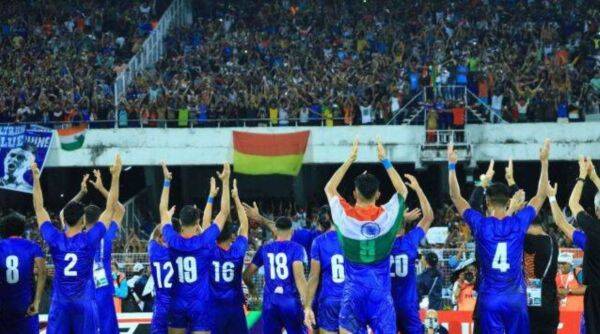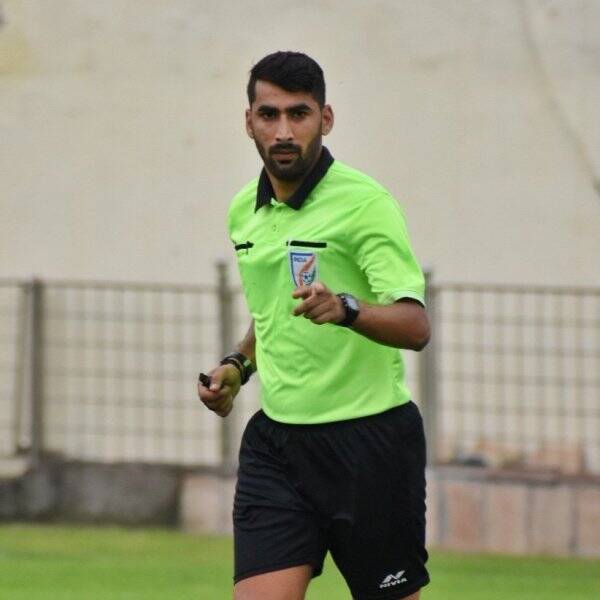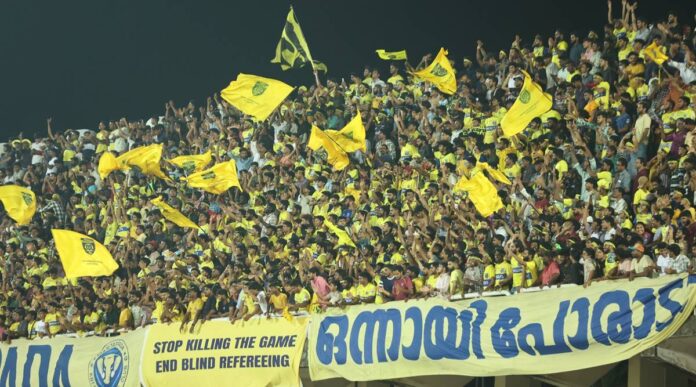Recommended for you
Chhangte scurries forward but a few yards away from the Hyderabad box, tumbles on the ground. The referee has a close look from roughly 10m away and waves play on, concluding that the India international fell because of his own mistake rather than being fouled by a defender.
The players don’t protest. But the decision riles up the fans.
In an instant, a section of the crowd, seated in the stand above the dressing room and behind a local train cutout through which players enter the field, begins to sing what’s become a customary chant at the Mumbai Football Arena.
“Ch***a referee,” the chorus echoes followed by synchronised claps before the cuss word is hurled once again at the match officials.
The man in the middle, Harish Kundu, wonders what he’d done to deserve the abuse, even three months later. “Chhangte hadn’t even asked for a foul,” Kundu, 31, says. “That’s when it hit me, ‘now I am in town.’”
Advertisement
Kundu, one of the youngest referees in the league, tries to not get affected. For him and others who have officiated in a match in Mumbai, where the abuse towards them is common and frequent during a match, the noise from the stands is just that – noise.
‘We are humans’
Managers have called them ‘liars’ and ‘jokers’. Players have labelled them as ‘disgrace’. And last month, the fans in Kerala unfurled a giant banner during a match that read: “Stop killing the game, end blind refereeing.”
India’s domestic football season ended last month with the same, old refrain that has overshadowed many recent ones: with fans, players, managers and the pundits bitterly complaining that the refereeing has gotten worse than ever.
Advertisement Fans in Kerala unfurled a giant banner during a match that read: “Stop killing the game, end blind refereeing.”
Put this to Trevor Kettle, Indian football’s Chief Refereeing Officer, and he is quick to rebut the allegations. “The real way of measuring referee success is to review the accuracy of the major game-changing decisions,” Kettle, who has officiated in more than 800 games across the top three levels of English football, says. “Prior to the last (ISL) season, the accuracy was around about 72 per cent. That improved to around 81 per cent (in the recently-concluded season).”
The numbers, Kettle insists, belie the claims of falling refereeing standards. At the same time, it’s hard to argue against the fact that there are blunders. But the problem, referee Rahul Gupta points out, is they ‘are remembered only for their mistakes.’
India isn’t an exception. Referee errors are a part of the football narrative globally and they are a soft target worldwide.
However, what’s on the rise in India season after season, isn’t only the controversial decisions, as alleged; the vitriol and violent threats have increased manifold. While the refs are quick to dismiss it as professional hazard and discount the abuse as ‘emotional outburst’ and ‘poor understanding of rules’, it has its effects – from self-imposed social media exile to sleepless nights.
“People need to understand we are humans,” Gupta, 38, says. “The fans don’t spare our families as well.”
Threats, abuse and attacks
Gupta knows, having experienced this first-hand.
Advertisement
In late 2019, his career had taken a giant leap after he was chosen for the South Asian Football Championship in Nepal. Before leaving for his maiden international assignment, Gupta had to take charge of an ISL match between ATK and Mumbai City at the Salt Lake Stadium in Kolkata.
It was a four-goal thriller that ended in a 2-2 draw and the match came to life in the second half, which saw tackles flying in thick and fast as well as two injury-time goals. There was no time to breathe, Gupta recalls, and after the match was over he returned to his hotel excited to leave for Nepal the next morning.
Advertisement
That’s until he turned on his mobile phone. “I don’t know from where but the fans got my number and the whole night, my phone kept buzzing,” Gupta says. “I was getting calls and messages from unknown people, some numbers from Gulf nations too. They used abusive language towards your parents and children. It distracts you mentally.”

This incident isn’t a one-off. And neither is it restricted to ISL alone.
Advertisement
Referee Senthil Nathan describes the harrowing time when he had to stand in the middle of the pitch for hours after he had sent off the home team’s player in a crunch I-League match against Mohun Bagan in January 2018.
Tempers had been on the boil throughout the match especially after Nathan had denied Aizawl a penalty and moments later awarded one to Bagan. But the tipping point came when he gave marching orders to Aizawl captain Alfred Jaryan.
“It (the red card) was in the 89th minute,” Nathan, 32, says. “The supporters went really wild. I had to be on the field for the next two hours, standing in the middle.”
Stones, bottles, chairs and abuse were thrown in his direction as the security guards struggled to control the crowd. “Then, the president of the club came with extra security people to calm down the situation and let me go,” Nathan says. “I can understand the emotions of the supporters but they weren’t looking at whether the decision I made was right or wrong.”
Kundu has a story from his debut ISL season in 2019, when he was the fourth official during Chennaiyin’s home match against FC Goa, which had descended into chaos with the referee dishing out seven yellow and two red cards.
In the closing stages, Kundu had reported the actions of the then Goa manager Sergio Lobera to the referee, who first booked the Spanish coach before showing him a second yellow card. In the fracas that followed, Chennaiyin’s assistant coach too was booked, which incensed the crowd that was already fuming over two possible penalties denied.
“The crowd got a little hyped,” Kundu says. “They waited for us referees outside the stadium. So, we changed into simple black t-shirts, got into a car and reclined in our seats… Eventually, when the convoy moved – there were security cars as is the norm – they spotted us and one of the guys started following the car that was ferrying the referee. After 15-20 minutes, the guy took a left turn and we carried on.”

Kundu laughs about it now but back then, he admits to having panicked.
Such incidents have reduced in the last few years – mainly because the 2020-21 and 2021-22 seasons were held in a bio-bubble. But the abuse and threats have moved online. It’s been so bad lately that Kettle says after the Bangalore-Kerala Blasters ISL semifinal, which saw the latter stage a walkout protesting a decision, he spoke to the referee Crystal John ‘every day for seven days to check on him’.
Shaji Prabhakaran, the AIFF secretary general, says more dialogue with the managers could help reduce this problem. “Everyone makes a mistake – someone misses a goal, someone tackles badly. A coach accepts that as a part of the game. So why are referees treated that way?” Prabhakaran asks. “If coaches exhibit respect towards referees, fans too will do that. Referees cannot be perfect. There will be errors and, sometimes blunders too. We have to take it as a part of the game.”
Air Force men, engineers, teachers
In the underdeveloped ecosystem of Indian football, refereeing has often been an afterthought.
In England, the refs became professional 20 years ago. In India, for all practical reasons, it’s started to happen just last year.
While criticising the standard of refereeing, it is important to note that until 2022, the match officials were forced to juggle between a proper day job to support their families and pursuing their hobby.
Gupta was a technician in the Indian Air Force for 20 years and was stationed in Punjab, Jammu and Kashmir and Gujarat. Nathan worked for tennis star Somdev Devvarman’s adventure sports company in Chennai, organising obstacle course races, triathlons and mountain adventure races. Kundu was a PT teacher at a school in Delhi, where he also taught them football while R Venkatesh was a chemical engineer.

All of them took to refereeing either because they suffered injuries as amateur footballers or came to a sobering conclusion that they wouldn’t make it big as players. And even though refereeing let them stay connected with the game, it was hardly a viable career option.
“Earlier, we used to get Rs 30,000 per month while the assistant referees got Rs 25,000 per month,” Venkatesh says. “After Trevor joined, we are getting Rs 50,000 and Rs 45,000 per month, respectively. So it helps us focus more on refereeing and it’s also motivating for the younger generation. Before, we had to do something else to run our family.”
While the cream of Indian footballers earn upwards of a crore per season, which enables them to focus solely on improving their fitness and tactical understanding, and managers too are compensated handsomely, the referees were left behind in this aspect, which stunted their growth for years.
Playing catch-up
On paper, football might only have 17 laws but in a match, Nathan says they have to process around ‘250-300 situations’. Applying rules to those match situations requires high physical fitness and mental alertness, which was tough while carrying out two jobs and tougher also because of lack of matches.
A perennial problem for India from a players’ perspective has been the lack of games. That issue is worse for the referees, who get fewer matches in a season than a player. In the first few years of the ISL, the situation was so bad that India had to import referees. That’s not the case now, but after being neglected for decades, Indian referees are playing catch-up, just like the players vis-à-vis their counterparts from mature football nations.
Last year, after the new All India Football Federation administration took charge, one of their first decisions was to hand professional contracts to the top eight referees, with the number likely to increase in the coming years.
These referees have their own coaches and analysts, who simulate match situations, provide strategic inputs and dissect their performances after each match. “We study the teams’ strategies, the formations they use in situations when they are winning a match or losing, the timing of their substitutions, the behaviour of the benches, the discreet signals players use during set-pieces… it’s pretty elaborate,” Gupta says.
Making referees mentally strong
During the recently-concluded season, Kettle introduced a concept that the Professional Game Match Officials Limited (PGMOL), the body that is responsible for refereeing in England and now involved in the Indian top tier, introduced in the Premier League and other divisions. “It’s called ‘Let’s Play’,” Nathan says. “Basically, the idea is to let the game flow.”
Kettle says the idea behind the ‘Let’s Play’ concept is to make the game more exciting for the viewing public. This also means an additional emphasis on fitness, with Kundu saying the referees now have to maintain the same body-fat level as players (around 12-15 per cent).
Kettle isn’t worried about the fitness bit – “they are some of the fittest referees I’ve dealt with,” he underlines – but in his immediate analysis, he realised the problem was more in the mind. “Mentally, not strong enough,” Kettle says. “That has come out slightly in my analysis of the key match incidents, especially when I start looking at the accuracy of serious foul play, violent conduct and dealing with those serious incidents. So that’s going to be a focus for us next season.”
Top Sports News Now
Click here for more
The Video Assistant Referee (VAR), too, is in the pipeline, with Kettle appointed as the project officer to implement it in India. Globally, VAR might have further fuelled the fire but the referees insist there is enough evidence to suggest it increases accuracy, especially in key match situations.
“We’ve already mentioned the key match incident accuracy. In England, in the Premier League that is around about 89 per cent without VAR. That increases to about 98 per cent with VAR,” Kettle says.
Also Read



“Mistakes are never going to go away,” Gupta admits. “Our aim is to reduce blunders. And from that point of view, we are headed in the right direction.”
© IE Online Media Services Pvt Ltd



